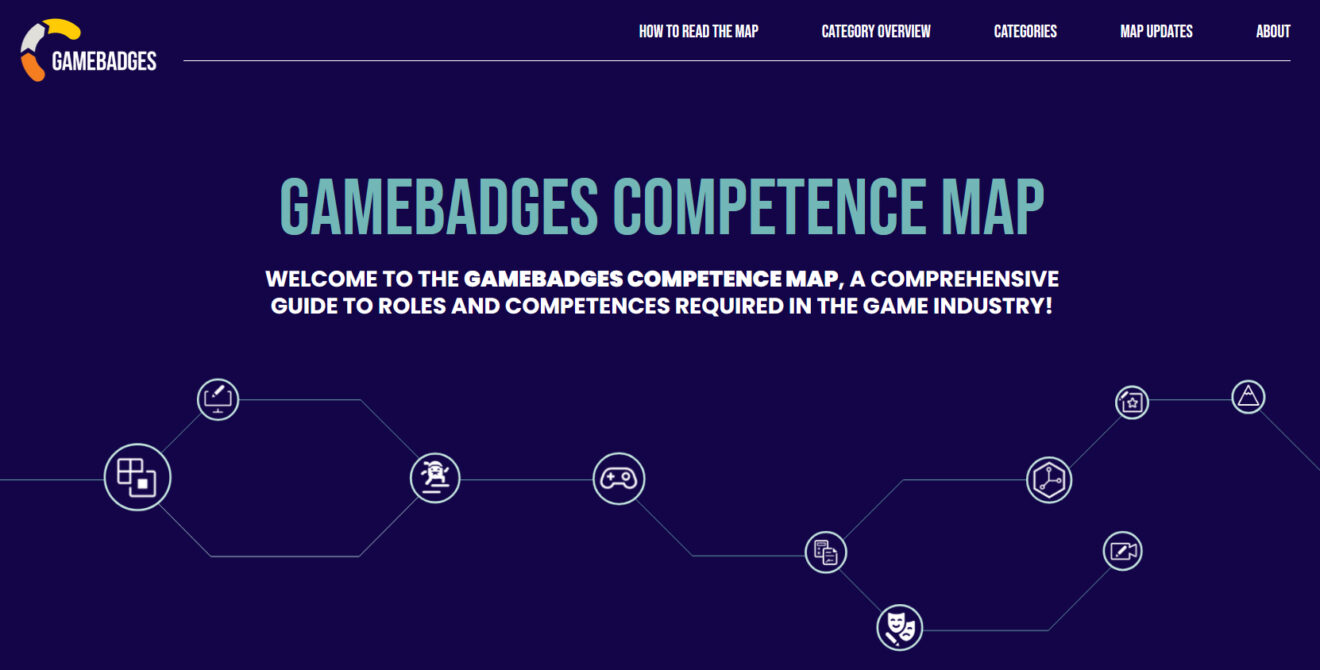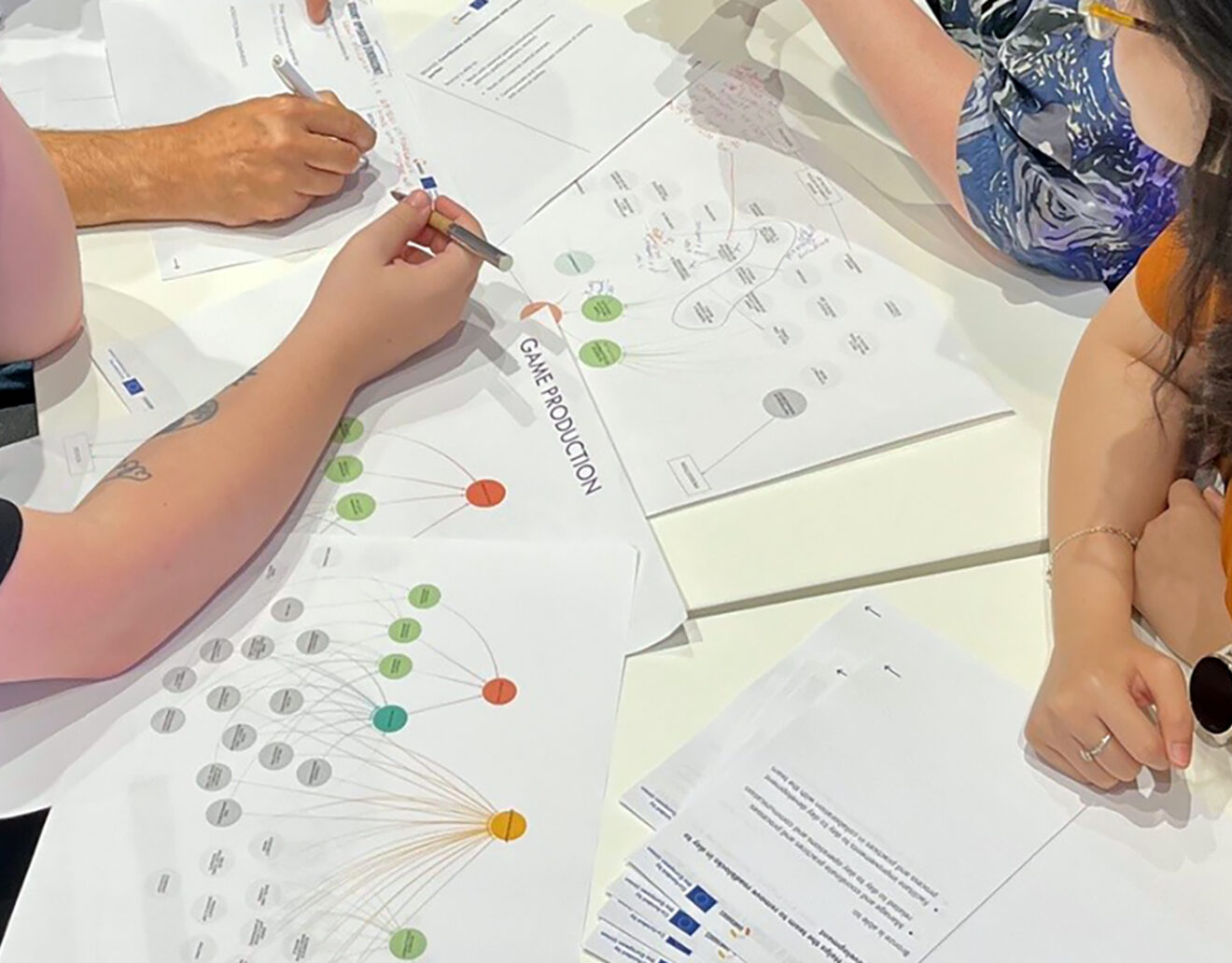In today’s fast-changing job market, proving competences can be more valuable than simply listing academic qualifications. While formal degrees still do have their place, employers are increasingly looking for clear, practical evidence of what you can actually do — especially when those competences have been developed outside traditional education. In fields like game development, a strong portfolio is often the key to opening doors to work life. Even so, it is not always clear how well someone’s competences align with the requirements of a specific role. That is where validated, task-specific recognition, such as open badges, can make a real difference.
Digital competence-based open badges are digital certificates of achievement and skills tied to assessment and evidence. There are numerous ways to create and use open badges, but the field has long been described as “the wild west.” Some badges have been used to validate school course competences, while others have been issued simply for participation in an event, webinar, or information session.
Both approaches have pros and cons. In the first case, imagine a situation where each school designs its own badges based on its own courses, and students use them when applying for jobs. HR departments could receive dozens of different-looking badges that, although seemingly similar, have varying competence descriptions. This inconsistency could reduce their credibility and employers’ willingness to engage with them. However, the topic still lacks thorough research.
In the latter case, if no learning is assessed, the result is not a competence-based badge, but rather a participation badge. I have outlined the differences and minimum requirements for badges in a 2020 article (Heinonen, 2020) as part of the “Chips for Game Skills” project (ESF, 2017–2020). That project also laid the foundation for the Gamebadges project, launched in February 2024 and introduced later in this article.
Micro-credentials vs badges
As society and the labour market continue to evolve rapidly, there is a growing need for more flexible and responsive ways to recognise learning. People increasingly need opportunities to update or broaden their competences in specific areas, whether to meet new job demands, shift careers, or keep pace with innovation. Traditional qualifications alone may not always provide the agility needed in this changing landscape.
Micro-credentials have emerged as a response to this need. They formally certify the outcomes of short, tailored learning experiences, enabling individuals to gain targeted skills and knowledge. While not intended to replace full degrees, they complement traditional qualifications by helping people bridge skill gaps.
The Council of the European Union has recognised the lack of common standards for micro-credentials in Europe as a key challenge, despite their growing use. This absence of shared definitions and frameworks makes micro-credentials difficult to understand and adopt, limiting their potential to support more flexible learning and career pathways. To address this, the Council of the European Union (2022) published a recommendation on a European approach to micro-credentials for lifelong learning and employability in 2022. The aim of the publication is to strengthen trust in micro-credentials among all stakeholders and promote their wider use across Europe.
The definition of micro-credentials provided in the recommendation emphasises the learning outcomes a learner has acquired following a small volume of learning. This may be the most significant difference between micro-credentials and open badges, as in the latter, the method or timeframe in which the competence was acquired and proven is not relevant. Otherwise, all other key characteristics of micro-credentials also apply to open badges, as they should be:
- assessed against transparent and clearly defined criteria,
- owned by the learner,
- shareable and portable,
- standalone or combinable into larger credentials.
While both aim to recognise and validate competences, they serve slightly different purposes and follow different standards. Understanding their distinction helps learners, educators, and employers choose the right tool for the right context, and strengthens the credibility and impact of alternative credentials overall.
Prior use and studies of badges
Studies on open badges have primarily focused on the education sector or on how to set up a badge programme (e.g., Abramovich et al., 2013; Brauer, 2019; Cheng et al., 2018; Devedzic & Jovanovic, 2015). However, the perspective of working life and professional applications has remained less explored.
The effect of digital badges on learner motivation was first studied by Abramovich et al. (2013) and later examined in a Finnish context, for example by Myllymäki & Hakala (2014). Brauer (2019) further explored the topic in her doctoral thesis, which focused on the use of badges in vocational teacher education. The findings suggest that a stage-based model using scaffolding, gamification, and digital open badges can support structured, flexible professional development for both pre- and in-service teachers, enabling them to customise their learning and acquire up-to-date competences.
Previous studies on the recognition of prior learning (RPL) offer another perspective on the use of badges. For example, Miguel et al (2016) conducted a survey measuring participants’ expectations and their perceptions of changes resulting from RPL. Pokorny (2006) highlights two key challenges in assessing prior experiential learning: first, the process of reinterpreting learning gained outside the academic context is often difficult and time-consuming for students; second, the learning must be measurable, as credit cannot be awarded for experience alone.
These are precisely the challenges that digital competence-based open badges aim to address.
The gamebadges project: A competence-based open badge ecosystem
The ongoing Gamebadges project aims to design, pilot, and implement a Europe-wide competence-based open badge ecosystem for the European game industry and game education. Metropolia UAS serves as the project coordinator, overseeing its implementation from February 2024 to January 2027. The ecosystem consists of two key components: an online Competence Map and digital open badges.

The Competence Map is an open-access website covering all game industry-related professions and their required competences. Building on the Chips for Game Skills project, a previous version of the Competence Map is already in use in several Finnish schools, where teachers use it to illustrate the diversity of the game industry. With clearly defined competence descriptions leading to specific skillsets, students can explore their own learning paths and identify the competences needed for their dream jobs. After conducting their own research, students can work with teachers to determine how, where, and when they can acquire the necessary skills since formal education may not always provide all required competences. Additionally, the Competence Map can help game educators align their course competence goals more closely with industry needs.
Open badges, on the other hand, can be applied for and earned in both game studios and game education to recognise and validate competences. Companies can use badges for staff skill-mapping, while graduating students can present them when applying for internships or jobs. In 2025, the project team will conduct testing in both professional and educational environments.
The application evaluation process aims to be as solid, yet as simple as possible for both the applicant and the evaluator. In our ecosystem, the badge applications are evaluated by a qualified professional (an evaluator badge holder), and the applicant either receives the badge or constructive feedback on a rejected application. A key advantage of earned badges is that they can be collected in a digital wallet and shared with job applications or LinkedIn profiles, helping bridge the gap between education and the game industry.
Research on open badges within the game industry
Open badges have been implemented and studied across various fields for some time (e.g., Ahn et al., 2014; Cheng et al., 2018; Young et al., 2019), yet their use within the game industry remains largely unexplored. One key part of the Gamebadges project is to produce research data that offers insights into the badge application process and the factors driving its adoption in both the game industry and education sectors (VET and HEI).
The research focuses on game professionals, students, and educators, examining the adoption of new badges (Gold, Silver, or Bronze levels) from three perspectives:
- Personal drivers and motives for applying for badges
- Perceived benefits and obstacles to badge use
- The extent to which badges encourage professional development
The perspective of game educators is particularly significant, as they act as gatekeepers for the adoption of the badge ecosystem within curricula.
Connecting education and industry
Digital open badges, when built on a solid competence framework, have the potential to bridge the gap between education and industry. The Gamebadges project is working towards a Europe-wide ecosystem that enhances transparency, supports lifelong learning, and strengthens professional pathways in the game industry. For graduating students, this provides a valuable tool to showcase their skillsets, making it easier to enter the job market and connect with potential employers.
Making competences visible in a structured way benefits not only individuals, but also educators and employers. As the ecosystem continues to grow, now is the time for stakeholders across education and industry to engage in co-creating a future where skills speak louder than formal qualifications.
References
Abramovich, S., Schunn, C., & Higashi, R. M. (2013). Are badges useful in education?: It depends upon the type of badge and expertise of learner. Educational Technology Research and Development, 61(2), 217–232.
Ahn J., Pellicone A., & Butler B. S. (2014). Open badges for education: what are the implications at the intersection of open systems and badging?. Research in Learning Technology, 22.
Brauer, S. (2019). Digital open badge-driven learning – competence based professional development for vocational teachers. Rovaniemi: Lapland University Press.
Cheng, Z., Watson, S.L. & Newby, T.J. (2018). Goal Setting and Open Digital Badges in Higher Education. TechTrends 62:190–196.
Council of the European Union. (2022). Council Recommendation of 16 June 2022 on a European approach to micro-credentials for lifelong learning and employability.
Devedzic, V. & Jovanovic, J. (2015). Developing open badges: a comprehensive approach. Education Tech Research Dev 63:603-620.
Heinonen, S. (2020). Identifying competence with digital badges – game industry competence target map. Osaamisen pelimerkit-website.
Miguel, M.C., Ornelas, J.H. & Morocco, J.P. (2016) Recognition of prior learning: the participants’ perspective. Studies in Continuing Education, 38:2. 179-194.
Myllymäki, M. & Hakala, I. (2014). Open Badges in Higher Education. Conference paper.
Pokorny, H. (2006). Recognising prior learning: what do we know? Re-theorising the recognition of prior learning, ed. Andersson, P. and Harris, J., 261-281.Leicester: NIACE.
Young, D., West, R., & Nylon, T.A. (2019). Value of Open Microcredentials to Earners and Issuers: A Case Study of National Instruments Open Badges. International Review of Research in Open and Distributed Learning. Vol. 20 (5).
Author
-
Saija Heinonen
Project Manager, Creative Industry TeamSaija Heinonen works as a project manager in Metropolia’s Creative Industries team. She has been piloting projects at Metropolia for over a decade and is currently leading the European Gamebadges project. Saija holds a Master’s degree in educational sciences and is passionate about psychology, behavioral sciences, sports, photography, and lifelong learning.
About the author

